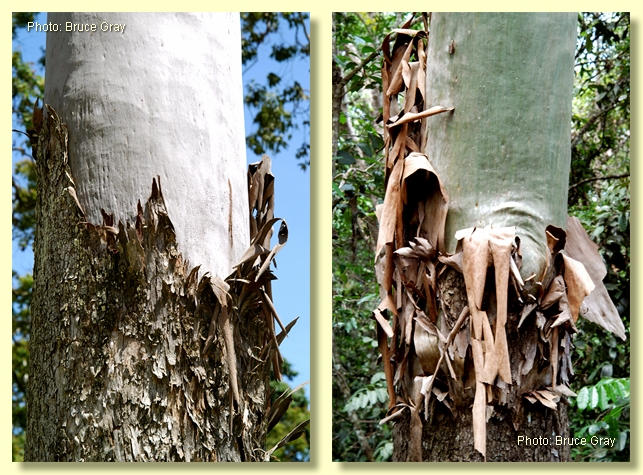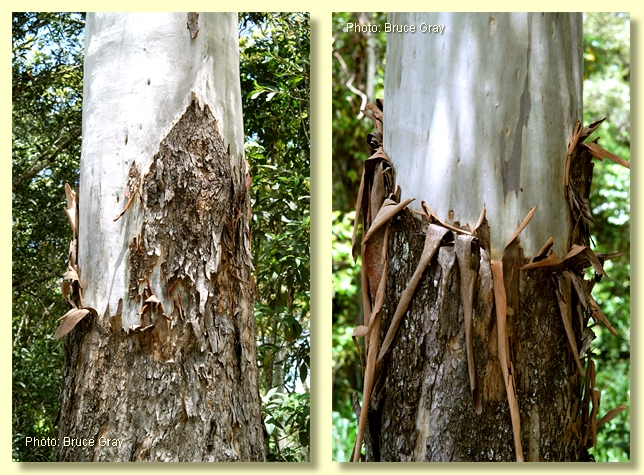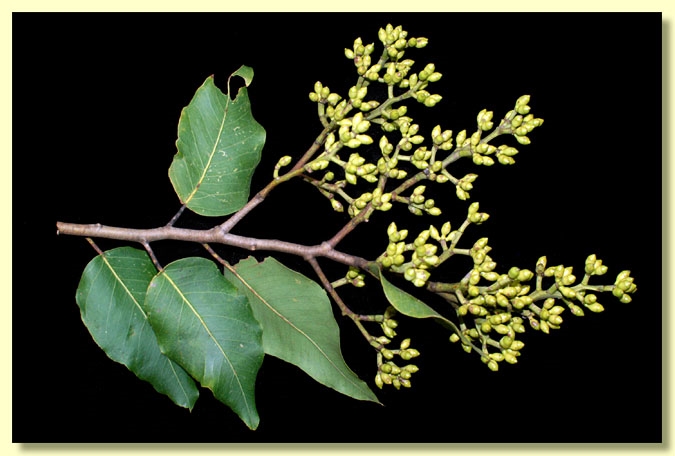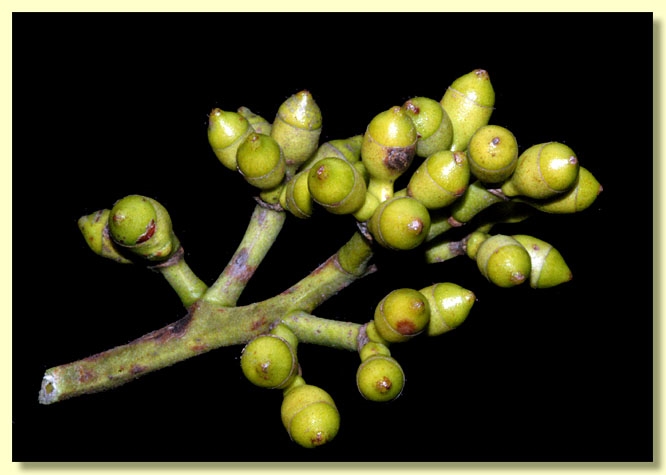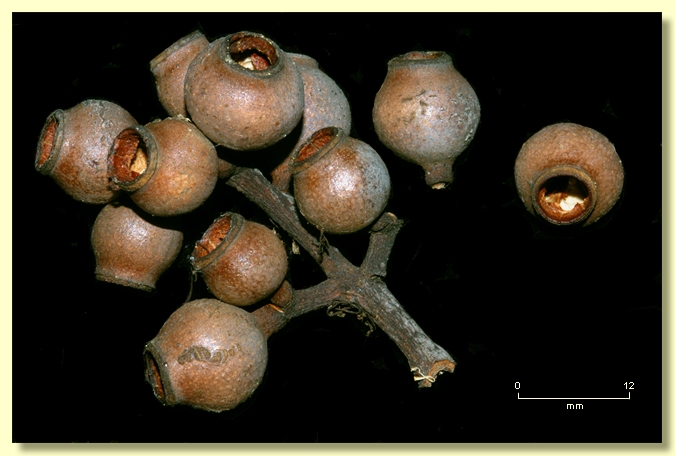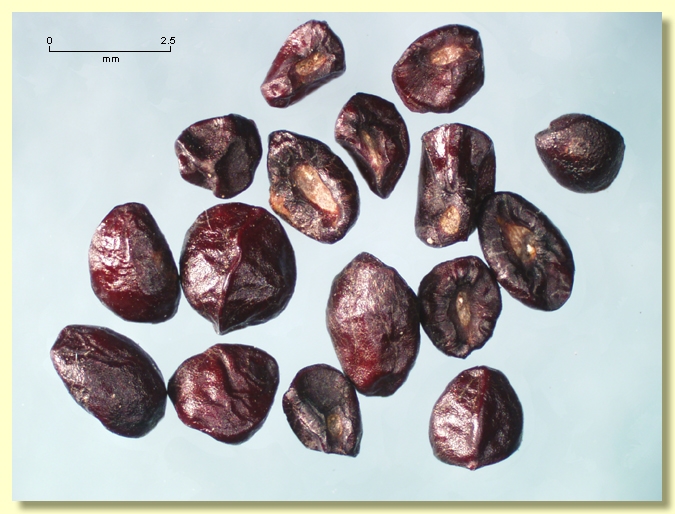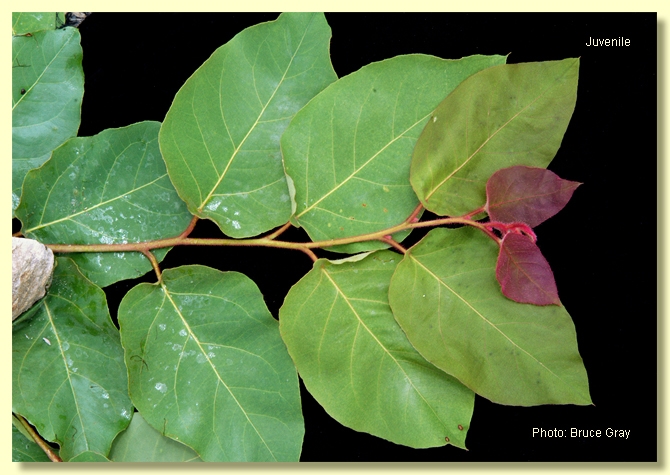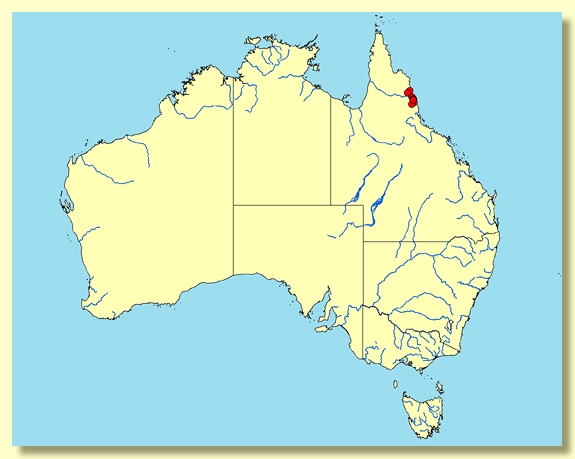Euclid - Online edition
Corymbia torelliana
Corymbia | Cadagaria
Tree to 30 m tall. The trunk of larger trees can develop buttresses towards the base. Not forming a lignotuber.
Bark of young but reproductive trees entirely smooth; older trees develop a rough ± tessellated grey-brown stocking over lower trunk to ca 5 m with the upper trunk and limbs smooth-barked. Smooth-bark greenish grey to white, often shiny.
Branchlets have elongated oil bodies in the pith; surface may be setose or glabrous.
Juvenile growth (coppice or field seedlings to 50 cm): stem rounded to square in cross-section, densely setose; juvenile leaves always petiolate, alternate, cordate to ovate or elliptical, (5.5)9–14.5 cm long, (4.5)6–10.5 cm wide, base peltate or lobed, discolorous, green; often glossy above, setose on both surfaces.
Crown of reproductive trees frequently of setose ovate intermediate leaves but may also develop glabrous lanceolate to narrowly lanceolate true adult leaves. The following description includes both types of leaf.
Crown leaves alternate, petiole 1–2.4 cm long; blade ovate or cordate to lanceolate, 6–16 cm long, 1.5–8.5 cm wide, base lobed, rounded or truncate on intermediate leaves, tapering to petiole on adult leaves, margin entire, apex pointed, discolorous, dull or glossy, green, setose or glabrous, penniveined, very densely reticulate, intramarginal vein parallel to and just within margin, oil glands island, numerous, small.
Inflorescence terminal compound, peduncles 0.5–2.4 cm long, buds 3 or 7 per umbel, sessile or shortly pedicellate (pedicels to 0.5 cm long). Mature buds ovoid to obovoid, 0.7–0.8 cm long, 0.5–0.7 cm wide, green to creamy, smooth, scar present (outer operculum shed in fragments well before flowering), operculum rounded to conical to slightly beaked, stamens inflexed, anthers ± cuboid, versatile, dorsifixed, dehiscing by longitudinal slits (non-confluent), style long, stigma blunt or mop-like, locules 3, the placentae each with ± 7 vertical ovule rows or the rows indistinct. Flowers white.
Fruit sessile or shortly pedicellate (pedicels 0–0.2 cm long), urn-shaped or, if lacking the short neck, truncate-globose, 0.9–1.4 cm long, 0.8–1.4 cm wide, disc descending, valves 3, enclosed.
Seeds reddish brown and shiny, 1.2–3 mm long, irregularly ovoid, often ± angular but without sharp ridges ventrally, dorsal surface smooth and at times with a longitudinal keel, not winged, hilum ventral.
Cultivated seedlings (measured at ca node 10): cotyledons reniform to orbicular; stems rounded to square in cross-section, densely setose; leaves always petiolate, opposite for 3 or 4 nodes then alternate, ovate to elliptical, 10–14.5 cm long, 4.5–9 cm wide, base rounded for lowest 2 nodes then peltate, discolorous, green, prominently setose.
Flowering has been recorded in August, October and November.
A quick-growing forest tree endemic to north Queensland, with restricted natural distribution in coastal ranges from Cooktown south to Ingham, extending inland only as far as the Windsor Tableland. Preferred habitats are well-drained soils on slopes in wet sclerophyll forest, the margin of rainforest patches and within rainforest patches where these patches have recently increased in area. Corymbia torelliana is often smooth-barked, developing a rough butt only when older, and can be fully reproductive even though it has a crown of intermediate setose to scabrid leaves, with true adult leaves developing tardily. Inflorescences form in compound clusters at the end of the branchlets with buds that shed their outer (sepaline) operculum early, leaving a scar. Fruit are urceolate to ± globose.
C. torelliana is a very distinctive species in its natural range with the combination of marginal rainforest habitat and morphology as outlined above. Very few other eucalypt species occupy this habitat, others being Eucalyptus tereticornis (Forest red-gum), which is always smooth-barked with concolorous glabrous leaves at all stages, and axillary bud clusters with the buds having a long horn-shaped operculum, and fruit with prominently exserted valves; E. pellita, a species in the Southern mahogany group, and which is completely rough-barked with long-fibrous brownish grey bark and discolorous glabrous leaves at all stages, axillary bud clusters and fruit with exserted valves; E. crebra, a fully rough-barked ironbark with concolorous glabrous narrow adult leaves, small buds in terminal inflorescences and small fruit with enclosed valves; and E. grandis, which is essentially smooth white-barked but develops a rough butt with age and increased size, often glaucous branchlets, discolorous glabrous leaves at all stages, axillary bud clusters and small obconical fruit with partially exserted valves.
C. torelliana is popular as a quick-growing garden and landscaping tree in more southerly regions especially in coastal and sub-coastal areas but is also used further inland, e.g. Narrabri, Chinchilla and Cunnamulla, as a street and backyard tree. In coastal areas around Brisbane and in northern New South Wales it unfortunately is a problem, escaping into disturbed and relatively undisturbed areas of rainforest and wet sclerophyll forest. It seems to compete very successfully with local species and has been recorded as hybridizing with species of the spotted gum group, especially C. henryi, on the north coast of New South Wales. C. torelliana is an acknowledged environmental weed in the greater Brisbane area.
MORE ABOUT CORYMBIA
UNGROUPED SPECIES IN CORYMBIA
Corymbia torelliana: named after Count Luigi Torelli (1810–1877).
Luigi Torelli was an Italian patriot, a soldier in the war of independence against the Austro-Hungarian empire, and later a politician, becoming a Senator of united Italy in 1860. He was a very active proponent of using eucalypts in agriculture, especially using water-loving species to dry out marsh areas to reduce numbers of mosquitoes and to lessen the incidence of malaria on rural human populations.


